Barcode scanners are the most inexpensive and effective way to control assets and inventory. There is little or no training required to use one. Barcode scanners are distinguished by their form factor and their scanning technologies. The main difference in form factors is the amount of operator manipulation required. There are wand or pen-style scanners, fixed-mount scanners, and handheld scanners. Handheld barcode scanners vary the most in available scanning technology. There are laser scanners, CCD scanners, which are also called linear imagers, 2D scanners, also called area imagers, and omnidirectional scanners. Each scanning technology has different features and benefits which make them ideal for various applications.
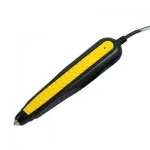 Wand or pen-style barcode readers
Wand or pen-style barcode readers require the operator to swipe the pen over the barcode. They are not limited by the width of the barcode, but they do require the user to pass the wand over the barcode at a consistent rate of speed and at a particular angle.
- Small
- Extremely durable
- Least cost
- Least efficient scanner
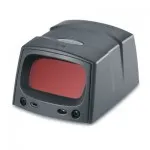 Fixed-mount barcode scanners
Fixed-mount barcode scanners read barcodes as they are passed in front of the scanner. Most fixed mount barcode scanners have a laser scan engine, so they must be mounted at a specific angle and distance from the barcodes that will pass in front of them. Unlike other barcode scanners, most fixed-mount barcode scanners are typically integrated with other equipment and automation systems.
- Widely used in work-in-progress applications and for high-speed sorting along conveyor systems
- Smaller models are commonly used in laboratory, security identification, and kiosk applications
- Must be mounted at a specific angle and distance from barcodes
- Typically integrated with other equipment and automation systems
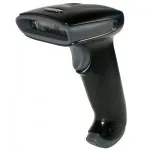 Linear imager barcode scanners
Linear imager barcode scanners are also known as CCD scanners, CCD LR (long range) scanners, and full array imagers. The scanning technology they employ uses no moving parts, thus making the linear imager barcode scanners more durable than laser barcode scanners.
- Durable (no moving parts)
- Better for reading damaged or poorly printed barcodes
- Better for reading barcodes under plastic film or covering
- Reading distances range from contact to two feet
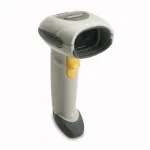 Laser barcode scanners
Laser barcode scanners are the most popular scanning technology in the industry. The brightness and sharpness of laser scanners offer greater preciseness and visibility when targeting a barcode, especially in bright light. Laser barcode scanners are also available in several variations to meet the needs of special applications, such as long range or high density scanning.
- Greater preciseness and visibility when targeting a barcode especially in bright light
- Extended range laser scanners can achieve distances of up to 35 feet when reading special reflective labels
- Ideal in forklift applications where greater read distances are required
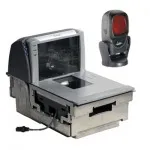 Omnidirectional barcode scanners
Omnidirectional barcode scanners can read a barcode no matter how it is orientated in relation to the barcode scanner. With handheld linear barcode scanners, the scanner is brought to the barcode and its scan line must be perpendicular to the barcode to read it. Therefore, the omnidirectional barcode scanners speed up the process and reduce user fatigue.
- Omnidirectional scan pattern quickly captures a barcode from a variety of angles
- Typically used in retail environments
- In-counter models are useful in high-volume applications, such as grocery stores
- On-counter models are good for applications with limited counter space
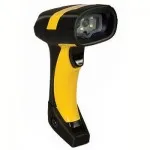 2D Barcode Scanners
2D Barcode Scanners can capture 2D barcodes as well as 1D, or linear, barcodes. They are gaining popularity because of their versatility and the future-proofing they offer as an investment. 2D Barcode Scanners use a combination of digital camera technology and software to capture barcodes.
- Captures 2D and 1D, or linear, barcodes
- Reads barcodes omnidirectionally, so the barcodes can be orientated in any direction
- Some models can also capture digital images and signatures
When choosing a barcode scanner, you must consider how it will be used in
your application and which model will be the easiest to use for
your workers. If it’s not easy and comfortable for them to use, then they might not use it, which not only means you wasted the money to buy the scanners, but also that your business is not benefiting from the increased accuracy and productivity that an effective barcode system can bring. For more help in finding the right barcode scanner for your industry and application, you can use the
Barcode Scanning 101 Guide or this
Barcode Printer Finder tool.





